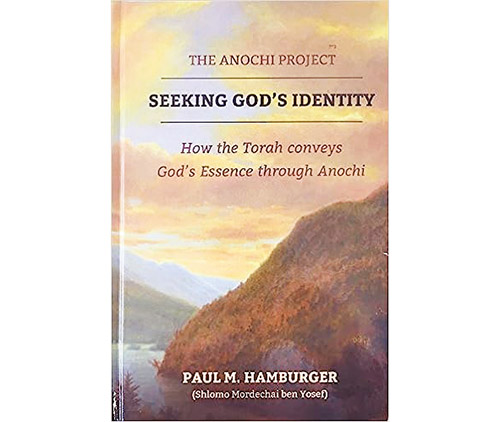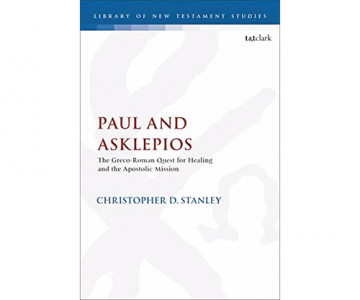
“The Anochi Project: Seeking God’s Identity,” by Paul M. Hamburger. 2018. 280 pages. Hardcover. ISBN-13: 978-1532358845.
In this work, Paul M. Hamburger assumes his alter ego Shlomo Mordechai Hamburger to take readers on a profound exploration of the meaning of the word “anochi” in the Torah. He begins by distinguishing between the Hebrew word “anochi” and its more common synonym “ani,” both of which are used by the first person to refer to himself (“I/Me”). In doing so, the author emphasizes the meaningful difference between the two words, with “anochi” representing God’s “signature” in This World (so to speak), which shows His hand in everything. The book then proceeds to examine classical rabbinical and Hasidic (especially, but not limited to, Chabad Chassidus) writings on the topic, drawing out a consistent and deeper meaning conveyed by the word “anochi” throughout the Torah, from Bereishit to Devarim.
This book offers a fresh perspective on God’s identity and the process through which His Essence was revealed to the world. One of the practical lessons Hamburger presents addresses the challenge of reconciling one’s Jewish identity with a desire to engage with the outside, secular world. To do so, he highlights the example of Abraham negotiating his place in a non-monotheistic society while facing the demands of Avimelech, an idol-worshiping Philistine king. Hamburger reveals how Abraham’s response in Gen. 21:24, Anochi Ishavei’a (“I will swear”), holds a deeper significance because by swearing allegiance to Avimelech and simultaneously affirming his faith in God, Abraham exemplifies the ability to maintain a Jewish identity while participating fully in the world-at-large.

This book is a treasure trove of knowledge, meticulously analyzing the references to the word “anochi” in the Torah and offering profound insights. Readers will find the book insightful, inspiring and incredibly interesting, yet presented in a readable English making it accessible to readers of various backgrounds. While the accuracy of the research cannot be verified by a non-scholar, the wealth of supporting evidence and well-placed notes certainly lend credibility to Hamburger’s assertions.
Although Hamburger comes from a totally different world than the largely Hasidic teachings that he cites, it is worth noting that Rabbi Shmuel David Luzzatto (1800-1865), also known as Shadal, in his commentary to Exodus suggests parsing the first of the 10 commandments differently than its common rendering. He reads it as: “I (anochi) Hashem, am your God who took you out of the Land of Egypt (Exodus 20:2),” with innovation of the revelatory aspect of this commandment being the fact that Hashem—the name of God that the Jews had already known from their forefathers—is the very same God who took them out of Egypt. The standard way of rendering this verse is “I am (anochi) Hashem, your God, who took you out of the land of Egypt,” with the emphasis on the fact that He who is revealing Himself at Sinai is none other than Hashem who had taken the Jews out of Egypt.
Either way, what sets this book apart is Hamburger’s ability to convey complex and sophisticated mystical ideas in plain English. He skillfully bridges the gap between profound concepts and everyday understanding, making the text relatable and engaging.
“Paul and Asklepios: The Greco-Roman Quest for Healing and the Apostolic Mission,” by Christopher D. Stanley (Chris Keith, series editor). T&T Clark, 2022. 264 pages. Hardcover. ISBN-10: 0567696553.

This fascinating study on healing and medicine in the classical world divides into two parts. The first half of the book offers a detailed account of the different health care options that pagans in the Greco-Roman world had. The author shows how there were essentially four “systems” of health care that operate side by side in that milieu. Namely, home remedies, “religious” remedies, “magical” remedies, and proto-medical care. The dominant modality used for run-of-the-mill sicknesses that was especially practiced by families in the countryside was the “home remedy” tradition that often passed down from generation to generation, but sometimes something stronger was needed.
In those cases, Greco-Roman pagans would turn to the many gods for a “religious” remedy, which usually entailed offering a sacrifice or a prayer to a specific god with intent that the deity help cure one’s ills. In particular, this book devotes much discussion to the healing centers associated with temples Asklepios (a Greek god associated with healing), but the aid of other gods was also invoked for their supposed healing abilities. This mode of healing was officially accepted as part of the civic religion practiced by pagan Greek and Romans. In addition, other “unsanctioned” modes of healing—termed “magical”—were also available. This often entailed appealing to freelance sorcerers who used various sorts of drugs, amulets and dream interpretation to help cure the ill by forcing the hand of the gods. Finally, people living the classical world also had access to physicians who practiced early forms of what we now would recognize as medical practice.
The first part of the book ends with the author showing how these four systems worked side by side, but were not as distinct as might be commonly thought. Instead, there was much overlap and cross-pollination between them, with different systems adopting and/or adapting elements of other systems and incorporating them into their own.
The second part of the book explores what the prevailing Jewish attitudes to health care may have been during the first century of the Common Era. This part of the book draws from the Bible, extra-biblical Jewish literature and rabbinic literature to try and tease out what sorts of medical practices were acceptable to Jews and what was considered beyond the pale. The author asks such questions as to what extent Jews followed the biblical bans against diviners and augurs when somebody’s health might be at stake, and how Jews viewed pagan and polytheistic medical practices that were explicitly associated with foreign gods and even invoked their names. The book concludes with two chapters that speculate about how early Christians may have fit into this discussion and what positions the early Christian leader Paul may have taken given his originally Jewish upbringing.
“The Six Days of Creation: The Garden of Eden, Dinosaurs, and the Missing Billions,” by Alexander Hool. Mosaica Press, 2022. 160 pages. Hardcover. ISBN-10: 1957579439.
In this work, Rabbi Alexander Hool tries to deal with the age-old question of the age of the universe. Like many other books devoted to reconciling Torah and science, he is bothered by the wide gap between the billions of years that science claims has elapsed since the creation of the Earth and the mere ~5,783 years documented by traditional Jewish sources.
As in his previous books, Rabbi Hool proposes an original and ingenious way of reconciling Torah tradition with secular sources. This time around, he draws on scholarship in the world of physics—particularly Einstein’s theory of relativity—to draw a distinction between fundamental time and general time. Based on that distinction, he argues that during the Six Days of Creation, time was stretched to amount to what we would nowadays consider a longer duration than merely six days. This explains why some elements of cosmology and the earth sciences seem to point to the notion that the earth is 13.8 billion years old. Rabbi Hool then demonstrates how traditional Jewish sources were already aware of the notion that the universe was expanding, but notes that according to those very same sources this expansion stopped during the Fifth Day of Creation. Later on, he discusses the idea that dinosaurs once roamed the earth, and likewise argues that these giant reptilians went extinct on the Fifth Day of Creation.
In this intriguing work, Rabbi Hool also engages in Jurassic paleogeography and the study of plate tectonics to discuss how the earth’s continents (Pangaea) may have looked in biblical times. He does this in order to shed light on where the Garden of Eden might have been located, how the Holy Land was located at the geographic center of the world, and where the gold of Ophir might be found. Overall, the author shows great familiarity with scholarship on geography, geology, archeology, astrophysics and other fields of science. His arguments are sound and well-formed, but it would take a real expert to truly assess the accuracy of what he presents. Whether or not what Rabbi Hool proposes is factually or historically correct, his charming book is full of information on the Bible’s creation story and how it collides with or merges with the findings of contemporary science.
Rabbi Reuven Chaim Klein is the editor-in-chief of The Rachack Review, an online forum for reviews of Jewish books. He is also the author of the highly popular work “Lashon HaKodesh: History, Holiness, & Hebrew” (Mosaica Press), and the Jewish Press’ “Fascinating Explorations in Lashon Hakodesh” column. He can be reached at [email protected].













